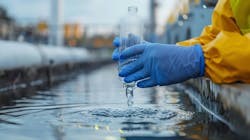Selecting the Right Polymer System Can Do Wonders for Water Quality
To help comply with EPA wastewater regulations and reclaim valuable resources, chemical polymers are added to industrial clarifiers, settling ponds, and other wastewater equipment at various stages of treatment. These polymers promote flocculation, a process in which small particles clump together into larger particles called flocs, which settle to the bottom. The clarified water can then be discharged for re-use, disposal, or further treatment.
The problem with this highly effective and economical method of removing suspended solids from wastewater is that not just any polymer will do. The polymer selected for the application and the preparation system that mixes and injects the product into the clarifier determines the quality of separation/clarified water, the dryness of solids, and the amount and cost of polymer required.
"Selecting the correct polymer, ensuring its proper preparation, and optimizing the chemical reaction all have a significant impact on water and solids quality. A more meticulous approach to polymer and the make-down system can reduce costs by lowering the amount of polymer required and ultimately produce better solids and cleaner, higher quality water," says Shane Schmutzler, president of Port Washington, WI-based Jadair International, Inc., a provider of systems for polymer preparation, water clarification, and materials reclamation for various industries.
To improve subpar flocculation outcomes, transitioning to superior polymers and preparation systems can promptly boost performance without modifying other existing system components.
"Replacing less effective polymers can reduce polymer costs by up to 50% while improving the experience of the operator, facility, and community," says Schmutzler.
According to Schmutzler, polymer suppliers often struggle not only in selecting the optimal polymer for the task but also in system design and application. Incorrect polymer preparation and application can lead to compromised water quality and increased chemical consumption. The costs escalate if the user is found to be non-compliant with local, state, or federal environmental standards, and fines are levied or corrective actions are mandated.
For optimal results, meticulous polymer selection is imperative. This includes a variety of polymers such as powdered and emulsion-type flocculants and coagulants.
To determine the best polymer for each application, Jadair provides water testing and evaluation services. This water testing (also known as jar testing) ensures optimum water quality and performance for all water clarification systems.
The company then works directly with multiple polymer manufacturers to identify the best product for each application.
"Ultimately, a polymer tailored to the specific process yields the best results, producing cleaner water along with higher quality solids," says Schmutzler.
Jadair also manufactures standalone polymer preparation systems in various forms and sizes that can be used with existing settling ponds, clarifiers, and other wastewater treatment equipment.
Polymers usually come in a concentrated powder or liquid form that must be transformed into a usable solution in a polymer preparation or "make-down" system.
"The concentrated polymer needs to be diluted, mixed, and prepared for application to optimize the polymer reaction and effectiveness," adds Schmutzler. The goal is to design the system so the polymer delivers the best reaction possible with the lowest polymer usage."
The polymer system can be used in conjunction with a clarifier system to improve the water clarification process.
"Our Settler/Clarifier Systems provide a continuous supply of clarified water while separating out thick, drier solids in an automated process," explains Schmutzler. "The process is even more efficient when using properly specified and prepared polymers."
With a Jadair Settler/Clarifier System, the polymer is injected into the water stream before it enters the machine. After the polymer promotes flocculation, the clarified water is discharged into a receiving tank for re-use. The system separates the suspended solids and brings them out in a thickened form that does not require secondary processing. The solids are removed from the machine and accumulate in front of the system, they can then be handled by a loader or belt conveyor.
"Our discharged solids can be easily scooped up by loaders and stacked for further drying or for sale to companies such as those involved in landscaping, landfill, or soil remineralization. What was once a waste product can become a saleable product," says Schmutzler.
Their polymer system can even be used with existing settling ponds or other equipment to help keep the water cleaner and make settled solids easier to handle.
Effective water clarification is crucial in numerous industries. Properly applied polymers and polymer systems can improve results while reducing wastewater and solids discharge problems. Industry experts utilizing optimal techniques to address these challenges can streamline operations, prevent environmental compliance violations, and recover valuable water and solids for reuse or disposal.
For more information, call (800) 669-3411 or visit jadair.com.
About the Author

Del Williams
Del Williams is a technical writer based in Torrance, California. He writes about health, business, technology, and educational issues and has an M.A. in English from C.S.U. Dominguez Hills.
